A guide prepares to release a salmon caught in B.C.'s Great Bear Rain Forest in 2006.John Lehmann/Globe and Mail
Mark Hume is a former national correspondent for The Globe and Mail and a Vancouver-based writer whose books include River of the Angry Moon and Trout School. His latest, Reading the Water, will be published next year.
The salmon was invisible in the river until its back, dark as storm clouds, broke the surface to take the fly. In the next few minutes it tore line off the reel, jumped three times and then stubbornly turned into the shallows, where it lay, awaiting whatever came next.
I held the fish for a moment in the cold water, its golden eyes looking into mine, then fixed forceps to the shank of the barbless hook and with a tug, released it, repeating a ritual that is about as close to a sacred moment as it gets for sports fishers. In 50 years of fly fishing in British Columbia I have released thousands of trout and salmon in that manner, never without feeling a sense of wonder. Catching and holding a wild animal that otherwise would rarely be seen, becoming for a glimmering moment a link in its great journey and then letting it continue on, is for many the main reason to fish. Food for the table is secondary.
But the practice of catch-and-release – a tradition for most of the 53 million sports anglers in North America – is under increasing attack.
Last year the Union of British Columbia Indian Chiefs wrote to the Canadian federal and B.C. provincial governments asking for a ban on catch-and-release, stating in an open letter that, “First Nations commonly view this practice to be akin to torture.”
The Haida Nation, which governs its traditional lands on an archipelago on B.C.’s northwest coast, feels the same way and is drafting a “code of conduct” for sports angling. It will mostly affect 18 high-end salmon lodges, whose clients take about 75 per cent of the recreational catch on Haida Gwaii each year.
Although the final Haida position hasn’t been released yet, some of the wording in the proposed code was leaked to the media earlier this year. “The Haida Nation does not support using catch-and-release to fish for entertainment,” it states. “To play with food is considered an unethical practice. This position follows thousands of years of practicing sustainable fishing as a way of life.”
Indigenous people aren’t the only ones questioning the method. In January of this year the Salmon Watchers Assistance Group, an organization based in Newfoundland and Labrador, filed a 258-name petition with the Minister of Fisheries and Oceans calling for a nationwide ban on “the selfish practice of catch and release.” And in the United States, People for the Ethical Treatment of Animals (PETA) has long been leading the fight to halt catch-and-release, calling it “cruelty disguised as sport.”
While those groups haven’t been getting any traction with governments in the U.S. or Canada yet, there is reason for them to hope. Catch-and-release has already been effectively banned under animal protection laws in Germany and Switzerland.
Meanwhile, sports anglers throughout North America continue to release the majority of their catch, in the belief they are helping to preserve stocks.
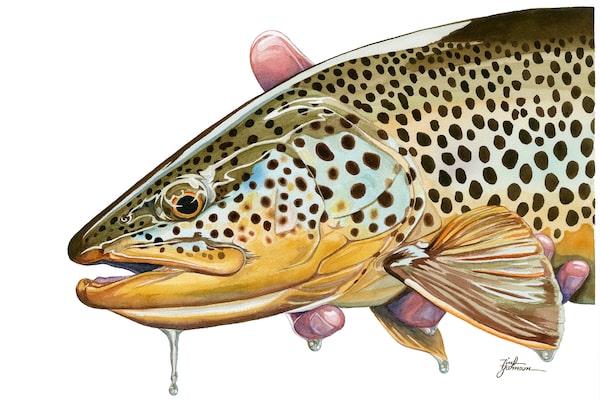
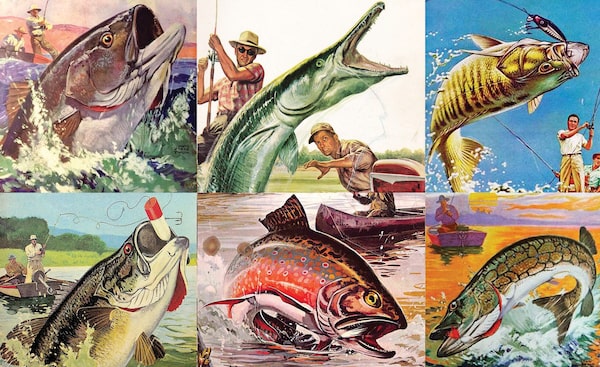
Fishy art through the ages: At top, a brown trout as painted by American artist and fly-fishing guide Tim Johnson; at middle, sporting-magazine covers from the 1950s and 1960s, when artists (some of whom also worked for pulp and horror publications) showed fish as monstrous leviathans; and at bottom, fish (a symbol of early Christianity) in a mosaic from an third- or fourth-century church in Israel.Ronen Zvulun/Reuters; painting by Tim Johnson
Fishing for food is woven into the fabric of humanity, with evidence of fish use dating back up to 250,000 years in Neanderthal caves. Sports angling, which emphasizes the experience of fishing over the importance of harvesting meat, might have evolved later, but it has been around for ages too.
Some of the earliest images of anglers casting for fish are found in Egyptian tomb murals, and perhaps the most evocative early portrait is a Roman Empire mosaic, Villa of the Nile, which shows two men fishing with flimsy rods while others nearby are busy setting nets.
In the Odyssey (written about 675-725 BCE) Homer describes “an angler on a jutting point, who with a long rod casts his ox-horn lure into the sea as bait for the little fish below, gets a bite, and whips his struggling prize to land.”
If the sole purpose of fishing was to get food, why would anglers in ancient Greece cast lures instead of using more efficient nets? Quite probably it was for the pure joy of catching a fish, as opposed to the basic need to harvest protein.
“Humans have been fishing for sport as well as food for almost as long as fishing has existed,” states Jon Lyman in an article, Ancient Indications of Angling and Ethics, published by the Alaska Department of Fish and Game.
“In Europe, angling for pleasure can be traced back to the first century A.D. In the Far East, sport fishing – with bamboo rods, silk lines, flies, and barbless hooks – dates back more than 3,000 years.”
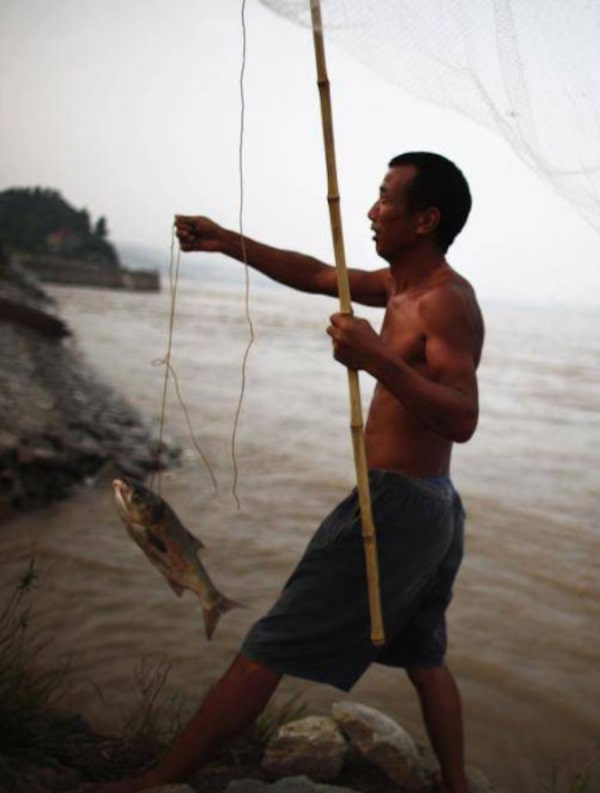
A local man catches fish on a bamboo rod in the Yangtze River in Yichang, Hubei province.Carlos Barria/Reuters
The first book extolling the virtues of fly fishing, is thought to be The Treatyse of Fysshynge wyth an Angle, written in 1496 by Dame Juliana Berners, an English nun. In 1653 Izaak Walton penned The Compleat Angler or The Contemplative Man’s Recreation, in which he describes fly fishing as being “somewhat like poetry,” because it is something you are either born to do, or not.
Those early writers favoured a cast line over a net because their goal was to savour the peace and contentment of angling, to get lost in its intricacies and rituals. Fish were seen not as a commodity to Berners and Walton: They were a means of escape. Fishing was then – and is now – a way to experience the natural world, a way to be drawn to the other side.
In 1828, Sir Humphry Davy, an English chemist famous for discovering several elements (and inventing the miner’s safety lamp) may have been the first to promote catch and release. He states in Salmonia: Or Days of Fly Fishing, that “every good angler, as soon as his fish is landed, either destroys his life immediately, if he is wanted for food, or returns him into the water.”
While catch-and-release has been enjoyed for centuries by sports anglers, its popularity began to grow in the late 1930s when two fly-fishing writers, Canadian Roderick Haig-Brown and American Lee Wulff, promoted it. They feared that the growing number of sports anglers would deplete stocks, and urged anglers to limit their kill.
It soon became one of the most significant, voluntary conservation movements in history and later became law. In the 1950s and ’60s, governments began to incorporate the practice into fishing regulations.
“Catch-and-release has become a fundamental component of fisheries management throughout the world in recent decades. It is a practice fully supported in a large body of published scientific literature,” Bob Hooton, a former steelhead biologist for the B.C. government, said in an e-mail. “Our own provincial government fishery managers have been in the forefront of application of C&R for more than 30 years. Without that tool, recreational fishing in this province would be doomed.”
Sockeye salmon make their way up the Adams River at Roderick Haig-Brown Provincial Park north of Chase, B.C., in 2010.John Lehmann/The Globe and Mail
Catch-and-release regulations are now used by fisheries managers in every province in Canada and every state in the U.S. Sometimes licences require anglers to release certain species, such as endangered steelhead. Sometimes fish of designated sizes must be let go – usually small ones to allow them to grow, but also large ones to ensure that the biggest live to spawn. On B.C.’s Fraser River, for example, all chinook longer than 80 centimetres (31 inches) must be released, because most of those really big fish are females, each carrying up to 5,000 eggs. In some locations sports anglers must release wild fish, while hatchery fish (identifiable by a clipped fin) can be kept. On some waters, all fish must be released, not because stocks are depleted, but in an effort to maintain high-quality sport fisheries.
Anglers have embraced the concept of releasing at least some of the fish they catch. According to a 2015 survey by the department of Fisheries and Oceans (DFO), Canada’s 2.6 million resident anglers caught 194 million fish and released 66 per cent. The data show they kept 20 fish on average, annually, while foreign anglers kept about 10.
In the U.S., 66 per cent of that country’s 50 million recreational anglers released some or all of the their catch, according to a 2020 report. And research from the US National Marine Fisheries Service shows that 8.5 million salt-water anglers released 64 per cent of the 956 million fish they caught, many of which could have been legally harvested.
If sports fishers killed their allowable legal limits, hundreds of millions of more fish would die annually. And soon there might not be enough left to support any kind of fishing.
Of course, letting a fish go doesn’t always mean it stays alive. According to critics of catch-and-release, fish are abused so badly in the process that, as PETA puts it, “they often die of shock.”
Some do succumb to stress or injury. However, research has shown the vast majority survive. A National Marine Fisheries Service review of 53 studies calculated the average mortality rate of fish released by anglers at 18 per cent. A review by the Ontario Ministry of Natural Resources of 118 catch-and-release studies, involving more than 120,000 fish and 30 different species, set the average mortality slightly lower, at 16.2 per cent. The Ontario review also found studies that showed postrelease death rates as low as 0.9 per cent for brown trout, 0.3 per cent for cutthroat trout and zero for Atlantic salmon.
Atlantic salmon fry are released into Toronto's Humber River in 2011.Peter Power/The Globe and Mail
Collectively the research indicates that how, when and where fish are caught plays a big role in their survival. Water temperature is a factor. A study of rainbow trout on the Gallatin and Smith Rivers in Montana found catch-and-release mortalities of up to 16 per cent when the daily maximum water temperature was higher than 23 C – but at less than 20, the mortality was zero.
Fish caught in deep water also don’t fare well because the swim bladder expands rapidly as they are brought to the surface, making it difficult for them to get back down. A law brought in last year by the U.S. House of Representatives requires anglers in the Gulf of Mexico to have descending devices on board their vessels, so fish can be released at a sufficient depth to recover. Recreational fishing groups pushed for that new regulation and typically have been quick to adopt practices that help fish survive.
The techniques sports anglers use to catch and release fish have evolved over the years. It is no longer acceptable for anglers to grab fish by the gills, land them with a gaff (a big hook on handle) or drag them up on shore. Recently there has been a shift to knotless cotton mesh or rubber landing nets, which are easier on a fish’s skin. (Landing a fish by hand without any net is considered best, although that takes a lot of skill and if done wrong can be damaging.)
DFO’s best practices for the release of Atlantic salmon lists 15 procedures anglers should follow, including using barbless hooks, landing fish quickly instead of extending the fight, keeping fish entirely underwater while unhooking them, and stopping fishing when water temperatures are high or river levels are low. Orvis, one of the leading suppliers of fly-fishing equipment in the world, has a video that explains how to release trout; the National Oceanic and Atmospheric Administration has videos explaining how to release big ocean fish, including sharks and swordfish.
By following the proper steps, anglers greatly increase the chances any fish will survive release unharmed.
One thing that isn’t known, however, is how many fish let go by sports anglers are later killed by predators. A study of bonefish in the Indian Ocean estimated that 43 per cent to 90 per cent of the fish caught on a hook and line were eaten by sharks soon after release. On Canada’s West Coast, sports fishing boats are often trailed by sea lions or seals, and on B.C. trout lakes, loons follow anglers. I have had aggressive birds dart under my net, attacking trout just as they were released; in the ocean, seals have ripped salmon from the end of my line. Studies are needed to quantify the affect of predation on released fish, and to determine whether additional fishing restrictions are needed in places where anglers and predators are concentrated.
A male fur seal sits amid fishing nets and ropes to defend its territory on Alaska's St. Paul Island in 2008.Al Grillo/The Associated Press
The mortality rate of fish that have been released isn’t the only reason sports fishing is under attack. Some people think it is cruel to catch a fish with a hook. Sir Davy responded to that criticism in 1828 by saying that compared with the slow death of a fish tangled in a net, angling is relatively harmless. It was a good answer then, but perhaps more needs to be said now.
When I taught my daughters how to catch and release fish, one of the first things they asked me was: “Does it hurt them?”
I was able to show them that a hooked fish doesn’t exhibit signs of obvious pain when handled carefully. A person with a hook in their lip would writhe in agony, but fish typically lie still, then dart off when released, without any sign of trauma.
Still, clearly they must sense something. But what? To answer that question I turned to science and found there is a debate about what fish feel. Some researchers see pain anthropomorphically, giving it human dimension, while others see it as a simple warning signal in a primitive brain that evolved, in salmon and trout, more than 80 million years ago.
A 2012 study published in Fish and Fisheries by a group of researchers led by James Rose, a professor emeritus in the Department of Zoology and Physiology and Neuroscience at the University of Wyoming, concluded that fish don’t have the neurological complexity needed to be able to process pain the way we do.
“Even if fishes were conscious, it is unwarranted to assume that they possess a human-like capacity for pain,” the paper states. “Overall, the behavioural and neurobiological evidence reviewed shows fish responses to nociceptive stimuli are limited and fishes are unlikely to experience pain.”
Nociceptors are the sensory cells that send pain signals to the brain, and Dr. Rose states they “are rare in teleosts and absent in elasmobranchs studied to date.” (Teleosts are ray-finned fish, which includes almost all the important sports and commercial species; elasmobranchs are cartilaginous fish, such as sharks.) When fish are hooked, he said, they don’t feel excruciating pain, but rather experience “injury signalling, triggering escape and avoidance responses.”
In other words, a fish runs and jumps on an angler’s line out of an instinctive urge to escape, not because it is suffering.
“It is very important to note that the flight responses of a hooked fish are essentially no different from responses of a fish being pursued by a visible predator or a fish that has been startled by a vibration in the water ... these flight responses of fish are a general reaction to many types of potentially threatening stimuli and can’t be taken to represent a response to pain,” he wrote in another article.
That view has been challenged by Victoria Braithwaite, a Penn State University biologist (who died in 2019) and Lynne Sneddon, director of Bioveterinary Science at the University of Liverpool. They argued in several papers that fish do feel pain – or at least that they might.
Dr. Sneddon, writing in the journal Animal Behaviour in 2014, said “the potential for pain perception” exists because some fish species do have nociceptors or “fibres that may act as nociceptors.”
She also said proof of pain reception was found in studies showing that when fish are given electrical shocks or are injected with noxious chemicals, they exhibit behavioural changes. The proposition being that if fish change what they are doing, after being subject to something that’s painful, then they must be feeling pain.
“Although it cannot be proven that animals experience pain, it also cannot be proven that they do not,” she concluded.
In a 2014 paper published in the journal Biology & Philosphy, Brian Key, a professor at the University of Queensland’s School of Biomedical Sciences, looked at the conflicting science and said it is difficult to defend the position that fish have “some hidden neural circuitry” that transmits pain.
“On the basis of our current understanding of the structure and function of the ‘fish’ brain, it [is] most likely that fish do not have the necessary neural machinery for phenomenal consciousness,” Dr. Key stated. “I subsequently propose that it is more plausible and probable to reason that fish do not feel pain.”
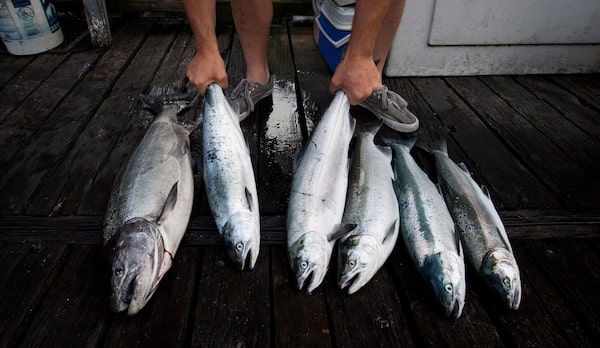
A fishing guide prepares to fillet salmon caught by customers on a guided tour in Vancouver in 2012.Darryl Dyck/The Canadian Press
Scientists do most of their pain studies in labs. Sports anglers only know what they see and experience in nature. Standing on the banks of Vancouver Island’s Stamp River last year I watched as salmon hurled themselves against the rocks, trying to get past a thundering waterfall. Nearby was the entrance to a fish ladder that allowed fish to easily ascend to calmer waters above. Many fish missed the gate, however, and jumped repeatedly, some until they killed themselves. Snorkeling in the canyon below the cataract I saw salmon, battered and ghost gray, drifting to the bottom. It would be wrong to assume that those fish hadn’t felt anything hitting the rock wall – but if they felt pain, if they felt agony and torment, why didn’t they do as Dr. Sneddon predicted and change their behaviour instead of beating themselves to death?
I have caught salmon that took my fly despite having open wounds left by seals; a friend caught a trout bleeding from the fresh puncture holes of osprey talons. Why would those fish return to feeding behaviour if they were suffering?
Getting caught and released by an angler does disrupt a fish’s life, but not so much that it impairs its ability to thrive. A study by Timothy Cline, published in the Canadian Journal of Fisheries and Aquatic Sciences in 2012, found that fish return to feeding after being released. He looked at 1,050 bass over a 27-year period and concluded that “catch-and-release angling had little impact on the overall seasonal growth patterns.”
Those who argue sports anglers abuse fish (the late University of Guelph ichthyologist Eugene Balon described sport fishing as sadistic) ignore the science regarding pain. They also misinterpret the motivation for angling (Dr. Balon said it was done “in order to satisfy some craving for torture or to feel superior”) and misunderstand the mechanics of it.
Playing a fish is exciting, but not because it’s an act of dominance. It is exciting because the fish is held by a small barbless hook, on a line so thin it is almost invisible. To successfully fight a big fish, an angler has to let go of conscious thought and trust instincts. That’s where the pleasure lies – not in a sense of dominance or the willful infliction of pain.
The methods used by anglers aren’t designed to hurt fish. A fishing rod is not a whip; it is a shock absorber. When a fish pulls on the line, it dips and bows, together with the drag on the reel providing a steady but yielding tension. A fish comes in when it is tired, usually after a few intense bursts of speed, which sometimes are punctuated by a jump. They may be fatigued, but fish spend their lives being chased by predators and they have the ability to recover from bouts of exertion. If they did not, every little fish chased by a big fish would die from stress.
A sockeye salmon is caught in a commercial fishing boat's net on the mouth of the Fraser River in 2010.DARRYL DYCK/THE GLOBE AND MAIL
Critics of angling say they are standing up for the rights of fish on humanitarian grounds. But if animal welfare is their real concern, they might want to consider the impact of nets, the primary tool used in commercial and Indigenous food fisheries.
Daniel Pauly, leader of the Sea Around Us project at the University of British Columbia, describes gillnets as working “like a forest-flattening bomb,” damaging almost everything that encounters them.
Injuries inflicted by nets include skin abrasions, large open wounds, fractured jaws or gill plates, and subsequent infection, according to a study by the University of Washington School of Aquatic and Fishery Sciences.
Each fall on B.C.’s salmon rivers I catch fish with flesh wounds from nets, the welts across their backs set in the form of mesh patterns. I let those salmon go with a prayer they can survive, but the odds are against them.
In B.C. alone last year more than two million salmon were caught in commercial gill and seine nets, but what isn’t known is how many fish escaped entanglement only to die later. A study in Washington State suggested it could be a lot. The research found that half the sockeye that were initially tangled in gillnets later wriggled free; within six days, about 60 per cent of those fish were dead.
A DFO review of 147 research papers included reference to a five-year Alaska study that found up to 44 per cent of sockeye on spawning grounds had gillnet injuries. More than half those damaged fish “failed to reproduce.”
Another study, on the Harrison River in B.C., found 100-per-cent mortality in sockeye, and 49-per-cent in chinook, “exposed to mild gillnet capture simulation.” The review found seine nets are just as lethal.
In addition to the damage nets inflict on target fish is the problem of unwanted bycatch. Nets are indiscriminate in what they entangle. Hundreds of thousands of water birds and an estimated nine million tonnes of non-target fish are discarded annually from nets set by commercial fishing fleets globally. The bycatch involves dolphins, sharks, turtles and just about everything else that swims in the sea. In the Gulf of Alaska last year, trawlers fishing for pollock accidentally scooped up and killed 26,000 chinook.
Anglers can target specific species, and if they do catch something they shouldn’t, they can let it go knowing there is an excellent chance it will survive. A study by the Alaska Department of Fish and Game showed 90 per cent of the chinook released in the recreational fishery on the Kenai River made it all the way to the spawning grounds, where they reproduced. (The fish were tracked by radio telemetry for more than a month.)
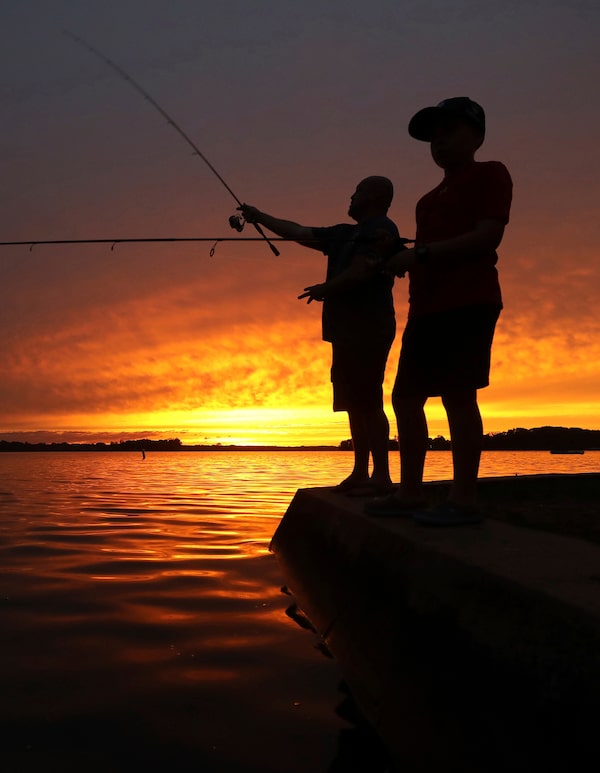
A father and son fish on the shores of Lac LaBelle in Oconomowoc, Wis.John Hart/Wisconsin State Journal via AP
But sports fishing isn’t without its faults. Lodges concentrate effort and can create unacceptable fishing pressure. Some anglers keep fishing after they have killed their limit, ignoring the fact that some of the fish they release may die. They fish in areas where protected fish are likely to be encountered, handle their catch roughly and hold them out of the water too long for photographs. In some cases guides lead their clients to the same fish, such as a steelhead resting in a specific location for several weeks, knowing it can be caught repeatedly.
Every sport has it slobs. Regulations are needed to stop unethical behaviour and to restrict the number of anglers if fishing becomes too intense. All sports fishers, when they buy their licences, should have to read or watch educational material explaining how to properly catch and release fish.
Although many anglers resist change, most usually welcome new rules that help maintain healthy stocks, even if it restricts their sport. For example, when the Washington Department of Fish and Wildlife announced new regulations regarding steelhead fishing on the Olympic Peninsula this year – prohibiting the use of boats, banning live bait and requiring the release of all wild rainbow trout – some sports fishers pushed for even more restrictions. The Conservation Angler organization wants periods where no fishing guides are allowed on rivers, along with limited entry to control the number of people fishing on a daily or weekly basis.
Most anglers honour the long traditions of their craft by treating fish with respect. They cradle fish in their hands, hold them while they recover from the fight and release them gently. When they do kill fish for the table, it is done quickly. Those who fish for food or profit using nets often leave fish to suffocate, bleed out or thrash themselves to death on boat decks. Those who eat fish, but don’t fish themselves, support a commercial seafood industry that annually kills about 94 million tonnes, damaging the environment and allowing masses of fish to die slowly.
To attack anglers for “playing with their food” is to mischaracterize an ancient sport that has been practised for thousands of years. Most recreational anglers aren’t driven by a need to put meat on the table. They are fishing for the sake of fishing; they are fishing because it’s a way of finding their place in nature. And that’s not something anyone should ban.
In the Great Bear Rain Forest, the salmon darts for freedom after the guide releases it.John Lehmann/Globe and Mail